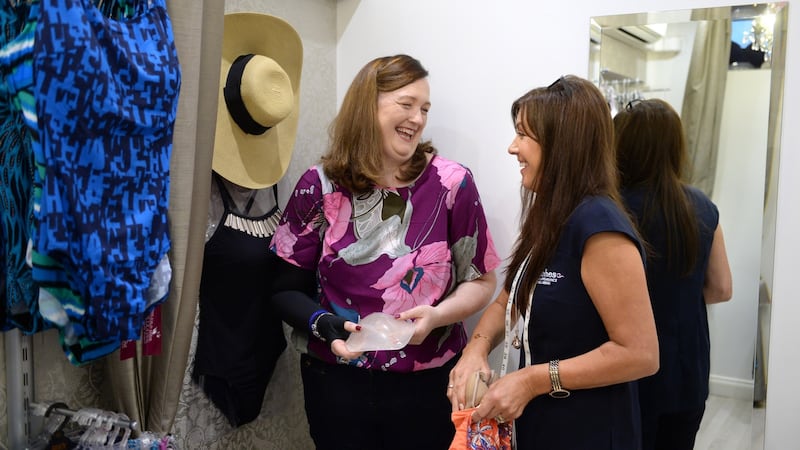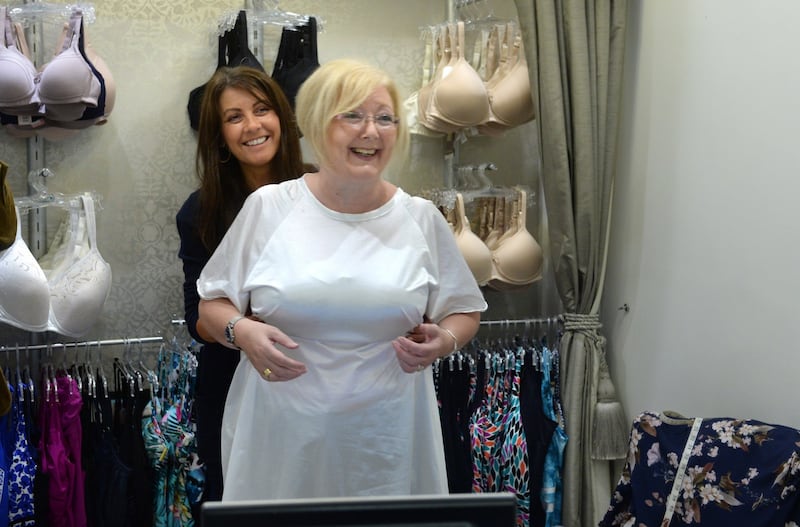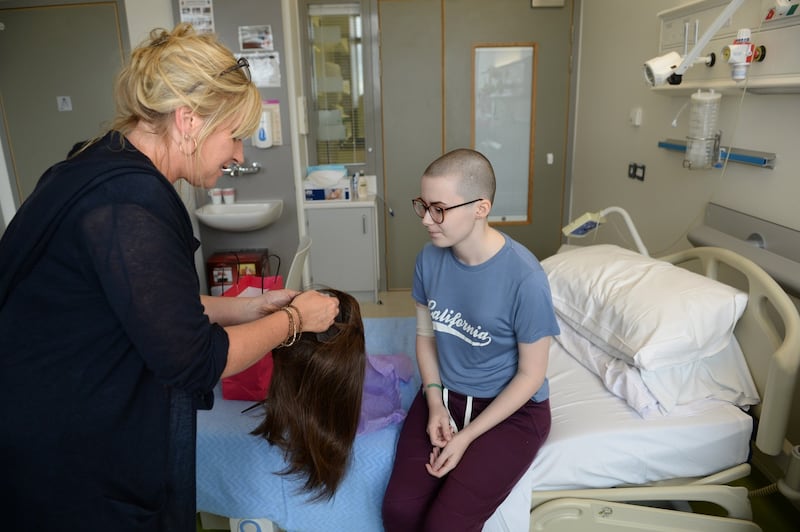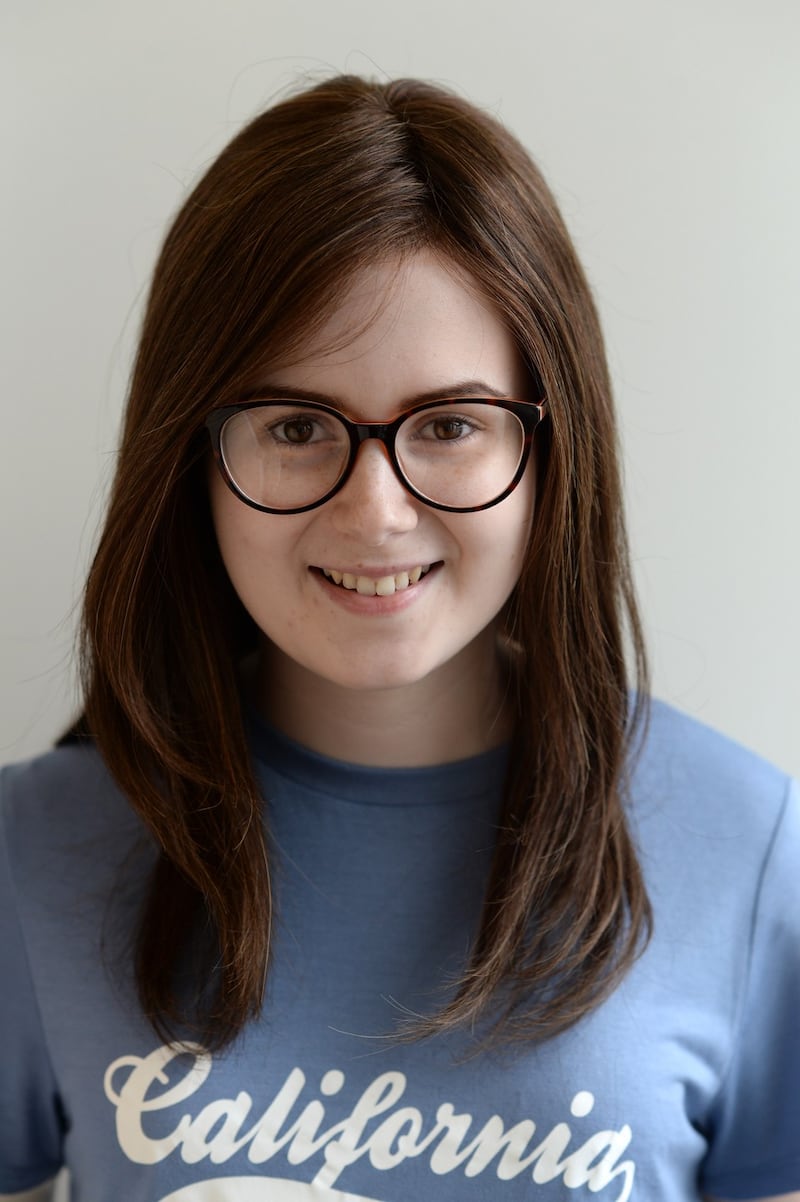On an autumnal Monday morning, a woman with blonde hair neatly tied back arrives for her hair appointment at a salon sandwiched discreetly between a barber shop and an optician’s on the Lower Kimmage Road in Dublin.
She and her friend take a seat in the waiting room, opposite a motto on the wall which reads “Looking good is feeling good”.
The waiting room has the usual array of magazines, and shelves lined with bottles of shampoo and hair treatment. The walls are painted a soft grey. There is a reception desk and a potted plant. It looks, in other words, like any one of the hundreds of other hair salons in the capital.

Or it would, were it not for a few items: the books bearing titles such as Survivor's Mindset and Getting Well Again, and a neat display of mastectomy swimwear and bras.

Robyn is called for her appointment to a room upstairs. After a while, her stylist, Patricia, returns. Robyn’s haircut is finished, she says, but she wants to give them a moment.
“It’s a bit emotional.”
Roches Positive Appearance Centre is like other hair salons in the sense that it offers cuts, colour and consultations to women, men and a few children. But it also provides some additional services: wigs, hair pieces, beauty treatments and workshops, and mastectomy wear, including bras and swimwear, for women who have had surgery.
For people such as Robyn, it is a place to come during treatment to “stay ahead of the hair loss”, as another client puts it, by having their hair cut short, or shaved off. They leave wearing a wig that “should be undetectable,” says Anne Roche. “That’s our goal.”
“We have teenagers, we have young women, we’ve got older women, we’ve got men. We have people having chemo, people with alopecia, people with trichotillomania. And then we’ve some men who wear toupees. You get people who are really, really upset. You get people who are unbelievably strong.”
The mood is upbeat in the breastcare room just beyond reception, where Margaret Byrne is in for a bra fitting ahead of her daughter’s wedding.

Byrne could shop in the lingerie department of any store, but – 16 years on from her breast cancer and partial mastectomy– she still prefers to come to Roches.
“I could go to M&S or the like, but you have to go through a lot to find the one that fits right and all the time, you’re taking your prosthesis in and out. It’s not the same level of privacy as here.”
Samantha Sherlock, who is fitting Byrne for her new bra, asks her if she wears underwired. “I don’t, but I used to. It might give me a nice shape.”
They select one made by an Irish company, Trulife. Byrne checks if I mind seeing her scars before she removes her bra and prosthesis to try it on. Having her breast removed was traumatic. “It’s your whole femininity. It’s your sexuality. Your relationship. Your confidence. Everything is affected.”
Reconstruction was not offered in Tallaght hospital when she had surgery 16 years ago. Afterwards, “I kind of thought, well surgery is surgery. And three years after, I developed a lot of clots and things that went up into my lungs. So I’m on warfarin for life. And to go through surgery again would be too much.”
Sherlock has had breast cancer too, so she is particularly sensitive to the needs of her clients. “With a prosthesis, you can’t wear anything low cut. Especially if you have a heavy prosthesis. Running, exercising, you can do that no problem. You can also get swimming prosthesis for the beach.”
Byrne volunteers that for her 60th birthday last year, she had a boudoir photoshoot done. “I should have brought it down to show you. My God, you wouldn’t have thought it was me. I said, ‘I’m doing it now, this is it. It’s my time’.”

She didn’t always feel so positive. Her experience when she was first referred by the HSE for a free prosthesis to a different shop was disastrous. “I had a letter, but they said they had no record of it. I was standing at the public counter, with all these people around me.” She went home after that, she says, and locked herself in the sitting room with some whiskey.
Sherlock was 36 when she got cancer. “Sometimes you can feel that you’re defined as the person who has breast cancer. My kids were quite young, five and 10. I remember going to the school Christmas play and my eyes were filling up thinking, would I be here next year. I was thinking: ‘Don’t cry, don’t cry. Don’t be the woman with the breast cancer sitting on her own at the top of the church crying’.”
Byrne adds: “Some people will back away from you. They don’t know how to deal with you. I’m an open book. I’ll talk about it freely. If someone asks, I’ll let them feel the prosthesis. But you can get a bit paranoid too, when your inner self isn’t feeling the best. Your confidence does go.”
Upstairs, Robyn is getting used to her shoulder length blonde wig. She touches the end of it, tentatively.
It looks identical to her real hair, her friend Jean assures her. “It’s better than my own hair,” Robyn says.
Losing her hair affected her badly. “Oh God, it’s terrible. I think when you look at other people who have cancer, you feel so sorry for them, and I didn’t want that. I bought one of those,” she says, pointing to a display of brightly coloured cotton hats. “But I don’t think I’ll ever wear it.”
Robyn was diagnosed in June, after she noticed some changes in her nipple, and felt a pain under her arm. “It’s just been a really quick process since the diagnosis, with all the hospitals and appointments. My hair loss has started already, so I got it cut very short. It was more stressful I think, at the weekend. Yesterday, before I went to take a shower, I had to have a glass of wine, because I didn’t know if I could look at it falling out.”
Was it emotional today? “No,” she says slowly. “It was okay. I’m trying not to cross that line too much. Might not be able to stop.”
She pauses for a minute. Everyone in Roches has been fantastic, she says. Professional and kind. Even so, “this is the worst part of all, I think, the hair. Even the kids came home on Friday evening and it was all falling out, and they were talking about golf lessons and hockey lessons, and sleepovers. And I’m thinking, ‘can we just calm down, can we please just stop’. Just while I’m in this transition, getting used to my hair loss, I don’t want other people around. You feel pressure to be positive. Even with the likes of my parents I had to go home and say I have cancer, but I nearly had to shrug it off.”
In the room next door, this morning’s only male client – a young-looking 70-year-old called Frank – is in for a fitting of his hair piece, which he gets replaced every 18 months at a cost of €650.
That’s the thing few people realise about wigs until they need one – they’re expensive, costing between €350 and €520 for fibre, and between €600 and €1,250 for human or heat-resistant hair, including all consultations. Medical card holders who have suffered hair loss for medical reasons can claim an allowance from the HSE, which varies from area to area, while coverage from private insurance companies also varies.
For Frank, it’s a necessary expense. Wearing a hair piece is like “going in and buying a suit of clothes, really. Just to make my appearance look a bit better. I would have had a great head of hair.”
That was behind one of the mistakes he made when he first lost his hair. “I went to get it done in a different place to here, and I opted for too much hair.”
When he returned to his job in a factory, one man came down the factory floor with a mop on his head. “It seemed a bit cruel. I worked with a lot of men that had problems with their hair. I don’t know how they felt inside because men don’t talk about their feelings. They talk about football and the price of drink and whatever. But I think I’m slightly different. I think I have a female side in me and I’m not afraid to show it.”
Frank’s hair piece looks very natural, I tell him. You can’t actually see where it ends and his own hair begins. His appearance is important to him: he still wears his old hair piece in bed. “My wife is 17 years younger than me, I don’t know if that has anything to do with it.”
Other clients come and go through Roches over the course of the morning. There’s a woman with alopecia, who doesn’t want to give her name and who was too embarrassed for a long time to confront the issue, but when she finally got a hair piece, her friends were all delighted for her.
There’s Anne Marie, who has an appointment for a wig fitting, after she was diagnosed with cancer for the second time in three years. She is stoic about her diagnosis, but wears the same, slightly stunned expression Robyn had earlier. “I was here nearly three years ago, and now I’m going back on a drug that I know I’m going to lose my hair,” she says.
“I don’t look forward to it. I don’t look forward to losing my hair again. I don’t look forward to being able to take part in things and having to be careful not to be in big crowds.”
There’s Leah Harrington. Getting a wig at Roches following her chemotherapy six years ago “gave me an identity again. When you look in the mirror, and you have your wig on, and you have your make-up on, you look half normal again.”
Harrington’s hair has now grown back, but she has memories of getting too warm – early menopause was one of the joys of her treatment – in restaurants, and “whipping the wig off and putting it into my handbag. You get your confidence back, and that’s half the battle.”
These days, she says: “I don’t feel like the old Leah at all. Going through something like cancer changes you, and often it might change you for the better in some ways, even if you don’t realise it at the time.”
The biggest mistake people make, says Roche – whose parents set the salon up 28 years ago – is thinking that they should use their hair loss as an opportunity to do something radically different. “Losing your hair, and all the research says this as well, is the thing people find the hardest. Your hair will grow back, whereas your breast won’t, but it doesn’t seem to matter,” she says.
“It’s because when you lose your hair, you can instantly be identified as having cancer. But when you have a wig that looks like yourself, you can choose who to tell.”
The salon started out of Roche’s father’s hairdressing business. “He had started to do a few wigs. then after my mother was diagnosed with ovarian cancer, she basically found herself in the wig room being fitted for a wig by my dad.”
Roche’s mother, a beautician, began to help out in the salon. “If somebody was upset, she’d come into the wig room, and she’d take her wig off and she’d say, ‘Look, I’m wearing a wig’.”
After she recovered from cancer, the couple made the decision to sell the main hair salon and focused exclusively on wigs.
The job can be draining, Roche says, but it is also “brilliant because we see people once they’ve come through it. We do first trims and organic colours, and we see them coming back in and their hair is starting to grow again and they’re looking a million dollars.”
Karen, a client from north Dublin has taken her wig off to show Roche where her hair is starting to growing back. They discuss whether she should shave it off to ensure the regrowth is more even.
Most of the time, Karen says, she doesn’t bother wearing her wig. “It’s too hot. I take it off in the car when I’m driving home, and I just hope I don’t get stopped for speeding or something.”
Karen’s first breast cancer diagnosis came just after her 50th birthday, the week before Christmas. Her second diagnosis came exactly one year later. “Two Christmases in a row, exactly the same week, two different cancers, two different breasts.”
The first time round, she had to have a lumpectomy and radiotherapy, so she didn’t lose her hair. She finished that in April 2016, and spent the summer getting well, taking part in exercise programmes. Then in December, she was called back for a routine mammogram. “I felt fine. I was maybe a bit tired. But I’d had a year of it. They phoned me the following day and said we’ve found something.”
Second time, “I wasn’t so lucky. I had to have chemo too.”
She came into Roches before the hair loss began, determined to do something radically different, but “luckily Patricia talked me out of it. I was all gung ho, I was going to have this fabulous red wig.”
You get all of human life through these doors, says Roche, as we head towards her car to go on a house call to a client who is in the Mater hospital.
Which kind of clients does she find toughest? “Children,” she replies, without missing a beat.
It is one of those younger clients we’re going to see now.

Niamh Flanagan (19) is sitting up on her bed when we enter her room, wearing a tracksuit and brown glasses framing her huge brown eyes, looking startlingly like a young Sinéad O’Connor.
“Everyone is saying that,” she grins at her dad, Denis. Her boyfriend’s sister came down from Sligo a week ago to shave her head. Niamh was dreading it, but she was pleasantly surprised. “When I looked in the mirror for the first time, I actually liked it. I mean it was weird – I didn’t feel like myself, but then I thought I know I’m going to get used to this.”

Roche helps her to fit her wig, which is chestnut coloured and shoulder length. “It’s identical” to her own hair, Denis says, shaking his head.
“It’s actually really comfortable. It’s not that heavy. It’s really soft. It’s so nice. I love it,” Niamh says, when she looks in the mirror.
When she is finished having her photograph taken for The Irish Times, she sits in a chair by the window.

“The first time I noticed the pain in my pelvis was in February,” she says. “It was just like a fiery pain on and off, like a sharp pain stabbing. It gradually started to come more often, and then around April I started to get pain in my back as well. I thought it was muscular, because I had been working as a care assistant for seven months.”
Her doctor sent her for an MRI on her back, “thinking that it was a bulging disc or something like that”.
That was in early July. “I got a call Friday morning to say that it was something abnormal in my left pelvis area which basically kind of sent signals to my head straight away.” The pain continued to worsen over the weekend. She was hospitalised on the Monday and on the Wednesday, “we were told that there was a tumour there”.
All summer, as she waited for a diagnosis, the pain worsened. At its height, “you would actually say that it looked like I was in childbirth for three days. It was like constant, constant pain.”
“It was unreal to watch,” Denis adds.
She was finally transferred from Sligo to the Mater in August, where she got intensive pain management and finally, after a further biopsy in Birmingham, a diagnosis. The news was not good: she has an osteosarcoma, a tumour in the bone, of the left pelvis.
“I’m the second in Ireland in the last 40 years or something to have it in their pelvis. It’s the most rare kind of place to get it, so I have been told I’ll lose my leg. That’s a given,” she says, matter-of-factly.
There have been tough days since the diagnosis, and there will be more to come but, they both say, the support the family has had from their community in Sligo has been “unbelievable. Overwhelming. It gives us strength. It’s just constantly like you feel you’re being given a push in the right direction.”
She has started writing a blog and, she thinks, it could be one of the reasons she’s been “so good through all this”.
She should have started college, where she was planning to study Pharmaceutical Science this month, but she’s okay about missing it. “I really feel everything happens for a reason, and if I was meant to go and do that course, I’d be there now. Now I’ve got time to decide. Now I’m thinking about writing.”
Since her illness, Niamh has noticed a change in herself. She is far less shy and self-conscious than she used to be. “She’s blooming like a flower,” Denis says.
She is aware of appreciating things she would not have noticed before. “Little finer details that I took for granted before, now I’m seeing them. I wish I could go back and actually just appreciate normal things. Just stop and ‘I’m lucky to be able to just come home from work and complain about the day’, or say ‘oh I’m so tired.’ I don’t know if I’m making sense,” she says.
“In an indirect way, I’m trying to tell people to please take a second and stop and think about something that happened today, and appreciate it. Just think it happened, and I got to experience it, and there are people who can’t experience it.”
As we leave her to more blood tests, Roche says that meeting people such as Niamh is the best thing about her job. “People dig deep. It’s extraordinary. It gives you such hope.”
Some names of clients have been changed at their request. Niamh Flanagan's blog is at niamhsjourneythere.wordpress.com




















